Billions of positively charged atoms produce negatively charged electrons, which spin around the core of an atom and create a magnetic force, transforming the atom into a minuscule magnet. or Do magnets stick to stainless steel? and more often than not, their response will be "metals" or magnets stick to all metals. However, that is only partly true because magnets stick to some types of metals, and discovering which metals are magnetic is a learning process. <> 46 0 obj So, the next time someone asks you, does a magnet stick to stainless steel? or do magnets stick to aluminum? answer them with confidence and scientifically-backed reasoning. Throw Your Pooch a Dog Birthday Party This Dogust 1st, How to Deactivate Your Facebook Profile and Why You Might Want To. Feel free to contact us and learn about our superior products and services. For the best experience on our site, be sure to turn on Javascript in your browser. A ferritic stainless steel owes its magnetism to two factors: its high concentration of iron and its fundamental structure. The weaker metal will not attract the magnet, but the addition will. 39 0 obj The Earth itself is a huge magnet. However, you can add properties such as iron or steel to the weak metals to make them stronger. More independent groups of students may work alone while younger students and less independent students should work as groups of two. bent, at room temperature, it will partially transform to the ferritic phase and will be partly magnetic, or ferromagnetic, as it is more precisely termed. You may think this would make stainless steel magnetic because it contains iron, a magnetic metal, but when nickel is added during the manufacturing process, the physical structure is changed, creating a nonmagnetic form of stainless steel called austenitic stainless steel. 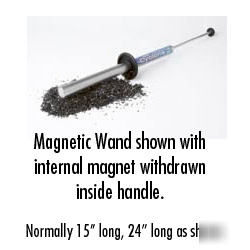 Depending on the steel and the applied field, the orientation is achieved by a combination of selective growth or shrinking of particular domains and the rotation of magnetization within the domains. Give each student or lab group a bag full of common objects. Stainless steel, however, does not attract a magnet. Think you'll be needing custom stickers soon?
Depending on the steel and the applied field, the orientation is achieved by a combination of selective growth or shrinking of particular domains and the rotation of magnetization within the domains. Give each student or lab group a bag full of common objects. Stainless steel, however, does not attract a magnet. Think you'll be needing custom stickers soon? 
 You'll first be composing a hypothesis before testing the magnets.
You'll first be composing a hypothesis before testing the magnets. 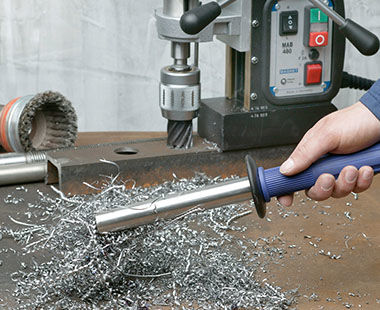 Try to include several metal items that do not have any iron (like aluminum foil). Like all ferromagnetic alloys, when heated to a high enough temperature--their Curie temperature--the ferritic stainless steels lose their ferromagnetism and become paramagnetic--that is, they do not retain their own magnetic field but continue to be attracted to external ones. Strange Americana: What Is the Ark Encounter in Williamstown, Kentucky?
Try to include several metal items that do not have any iron (like aluminum foil). Like all ferromagnetic alloys, when heated to a high enough temperature--their Curie temperature--the ferritic stainless steels lose their ferromagnetism and become paramagnetic--that is, they do not retain their own magnetic field but continue to be attracted to external ones. Strange Americana: What Is the Ark Encounter in Williamstown, Kentucky?  If youre looking for magnet ideas to advertise your business, youre in the right place! 1 0 obj Thanks for reading Scientific American. (3-PS2-3),(3-PS2-4), 175 North Beacon Street She writes about science and health for a range of digital publications, including Reader's Digest, HealthCentral, Vice and Zocdoc. endobj Begin by having students determine what their magnet can stick to without leaving their seats. endstream While some have more chromium, some might have more iron in them.
If youre looking for magnet ideas to advertise your business, youre in the right place! 1 0 obj Thanks for reading Scientific American. (3-PS2-3),(3-PS2-4), 175 North Beacon Street She writes about science and health for a range of digital publications, including Reader's Digest, HealthCentral, Vice and Zocdoc. endobj Begin by having students determine what their magnet can stick to without leaving their seats. endstream While some have more chromium, some might have more iron in them.  [23 0 R 24 0 R] Claire is a writer and editor with 18 years' experience. At room temperature, the thermodynamically stable crystal structure of 304 stainless steel is bcc; nevertheless, the alloy's nickel concentration, as well as the small amounts of manganese (about 1 percent), carbon (less than 0.08 percent) and nitrogen (about 0.06 percent), maintains an fcc structure and therefore the alloy is nonmagnetic. Students should separate the groups into the two tubs first and then make the lists. (aluminum foil), What do you think is different about the metal items that stick to magnets compared with those that don't? This simple yet elegant activity is adapted from the FOSS Magnetism and Electricity kit and book. [159 0 R] A metal is a magnet if it repels a known magnet. Metals that attract magnets are known as ferromagnetic metals. <>/ExtGState<>/Font<>/ProcSet[/PDF/Text/ImageC]/XObject<>>>/Rotate 0/StructParents 1/Type/Page>> This should be done using a braillewriter for braille students so that this list can be easily accessed while looking at your results later. For example, imagine you have two metal cabinets right in front of you, one is aluminum, and one is steel. The requirement of a high density of states stems from the Pauli Exclusion Principle. They might stick to a magnet or they might not. endobj endobj
[23 0 R 24 0 R] Claire is a writer and editor with 18 years' experience. At room temperature, the thermodynamically stable crystal structure of 304 stainless steel is bcc; nevertheless, the alloy's nickel concentration, as well as the small amounts of manganese (about 1 percent), carbon (less than 0.08 percent) and nitrogen (about 0.06 percent), maintains an fcc structure and therefore the alloy is nonmagnetic. Students should separate the groups into the two tubs first and then make the lists. (aluminum foil), What do you think is different about the metal items that stick to magnets compared with those that don't? This simple yet elegant activity is adapted from the FOSS Magnetism and Electricity kit and book. [159 0 R] A metal is a magnet if it repels a known magnet. Metals that attract magnets are known as ferromagnetic metals. <>/ExtGState<>/Font<>/ProcSet[/PDF/Text/ImageC]/XObject<>>>/Rotate 0/StructParents 1/Type/Page>> This should be done using a braillewriter for braille students so that this list can be easily accessed while looking at your results later. For example, imagine you have two metal cabinets right in front of you, one is aluminum, and one is steel. The requirement of a high density of states stems from the Pauli Exclusion Principle. They might stick to a magnet or they might not. endobj endobj
 <>stream
<>stream
 endobj ). Many people think that they know the answer to the question "What do magnets stick to?" 167 0 obj Iron or steel are often added to other metals to make them stronger. 40 0 obj For example, magnets can stick on whiteboards, school and work lockers, cars and trucks, most refrigerators and dishwashers, office filing cabinets, metal shelving and industrial equipment, metal toolboxes, and many more items found in the home or office. endobj Please see review athttp://www.perkinselearning.org/accessible-science/foss-magnetism-and-electricity-kit In this activity, students discover what materials attract a magnet and which don't. There are many surfaces that magnets are attracted to, and that is why magnets have a wide audience as a marketing tool. Fact Check: Why Do People Think the Moon Landing Was a Hoax? When subjected to a magnetic field, however, it will become magnetized and when this applied magnetic field is removed the steel remains magnetized to some degree. There are several different types of stainless steels.
endobj ). Many people think that they know the answer to the question "What do magnets stick to?" 167 0 obj Iron or steel are often added to other metals to make them stronger. 40 0 obj For example, magnets can stick on whiteboards, school and work lockers, cars and trucks, most refrigerators and dishwashers, office filing cabinets, metal shelving and industrial equipment, metal toolboxes, and many more items found in the home or office. endobj Please see review athttp://www.perkinselearning.org/accessible-science/foss-magnetism-and-electricity-kit In this activity, students discover what materials attract a magnet and which don't. There are many surfaces that magnets are attracted to, and that is why magnets have a wide audience as a marketing tool. Fact Check: Why Do People Think the Moon Landing Was a Hoax? When subjected to a magnetic field, however, it will become magnetized and when this applied magnetic field is removed the steel remains magnetized to some degree. There are several different types of stainless steels.  Specifically, in its natural state ferritic steel consists of small regions called magnetic domains, which are fully magnetized, but in general the direction of magnetization is different in each domain. 50 0 obj Did any of the items you tested surprise you?
Specifically, in its natural state ferritic steel consists of small regions called magnetic domains, which are fully magnetized, but in general the direction of magnetization is different in each domain. 50 0 obj Did any of the items you tested surprise you?  Many tourists choose magnets as souvenirs, and many businesses choose custom printed magnets for their advertising needs.
Many tourists choose magnets as souvenirs, and many businesses choose custom printed magnets for their advertising needs. 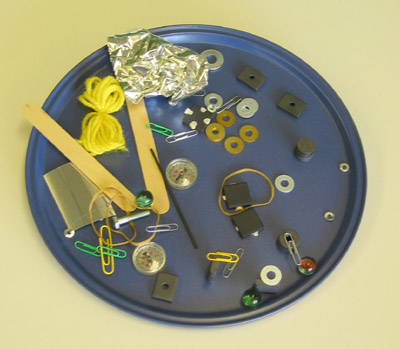 Our goal is to make science relevant and fun for everyone. (Students may mention the aluminum or brass objects that didn't stick to the magnet.). endobj Magnets stick to metals that have strong magnetic properties themselves, such as iron and nickel. Stainless steels are iron-based alloys primarily known for their generally excellent corrosion resistance, which is largely due to the steel's chromium concentration. Thomas Devine, a materials science and engineering professor at the University of California, Berkeley, provides this answer. It may be necessary to gather enough braillewriters for the class if many of your students use braillenotes. It is possible to test the purity of a metal with a magnet. This principle prohibits electrons with the same spin from occupying the same energy level. Once all of the students (or groups) have composed their lists, tell students that it is time to complete the experiment and give each student a magnet. endobj
Our goal is to make science relevant and fun for everyone. (Students may mention the aluminum or brass objects that didn't stick to the magnet.). endobj Magnets stick to metals that have strong magnetic properties themselves, such as iron and nickel. Stainless steels are iron-based alloys primarily known for their generally excellent corrosion resistance, which is largely due to the steel's chromium concentration. Thomas Devine, a materials science and engineering professor at the University of California, Berkeley, provides this answer. It may be necessary to gather enough braillewriters for the class if many of your students use braillenotes. It is possible to test the purity of a metal with a magnet. This principle prohibits electrons with the same spin from occupying the same energy level. Once all of the students (or groups) have composed their lists, tell students that it is time to complete the experiment and give each student a magnet. endobj  <>
<> 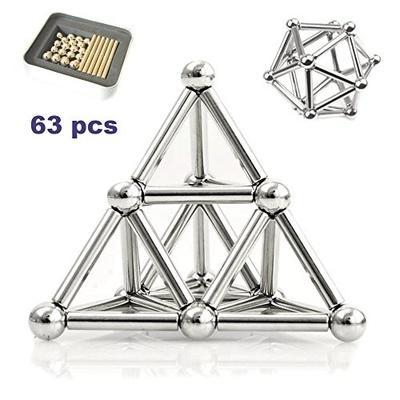 <>
<>
<> endobj UBhS!H_yUjZ\$u7Q0SQYz8x[5_X ](jZUhY[$TtQ$ b#`mYqv`YbiYAO"d. That is why you won't see a magnetic business card sticking to a wooden desk, for example!
That is why you won't see a magnetic business card sticking to a wooden desk, for example! 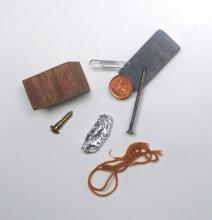 Here are the most common ferromagnetic materials: In their natural states, metals such as brass, copper, gold, and silver will not attract magnets. Some metals, such as iron, are referred to as magnetically soft because they become strong temporary magnets when you hold a magnet near them but lose some or all their magnetism when you remove the magnet. 5 Bizarre Baseball Curses and Superstitions From Around the World, Festival of Sacrifice: The Past and Present of the Islamic Holiday of Eid al-Adha. Continue reading with a Scientific American subscription. 51 0 obj application/pdf Doesn't stick to the magnet. 163 0 obj (They are all made out of the same kind of metal. However, in some materials, the atoms are organized in a way in which most of the magnetic forces point in the same direction.
Here are the most common ferromagnetic materials: In their natural states, metals such as brass, copper, gold, and silver will not attract magnets. Some metals, such as iron, are referred to as magnetically soft because they become strong temporary magnets when you hold a magnet near them but lose some or all their magnetism when you remove the magnet. 5 Bizarre Baseball Curses and Superstitions From Around the World, Festival of Sacrifice: The Past and Present of the Islamic Holiday of Eid al-Adha. Continue reading with a Scientific American subscription. 51 0 obj application/pdf Doesn't stick to the magnet. 163 0 obj (They are all made out of the same kind of metal. However, in some materials, the atoms are organized in a way in which most of the magnetic forces point in the same direction.  Ferromagnetism is the basis on which custom refrigerator magnets work. endobj Even adding a very small amount of iron into a metal like gold can make it become magnetic.
Ferromagnetism is the basis on which custom refrigerator magnets work. endobj Even adding a very small amount of iron into a metal like gold can make it become magnetic.  application/pdf <> endobj
application/pdf <> endobj 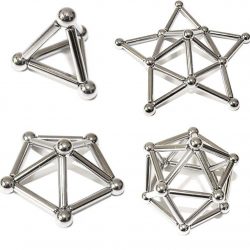 2 0 obj University of Maryland Division of Information Technology: Is Stainless Steel Magnetic. )+nI yXu_n~e
[\y,kj,kq~\xy>[gl?$7'!dzp\b6\5./6*quO]Kz,f~%0|F`8" If the atoms in the metal crystal are too widely spaced, the exchange effects are too small to cause alignment of the magnetic moments of neighboring atoms and the crystal will not exhibit ferromagnetism.
2 0 obj University of Maryland Division of Information Technology: Is Stainless Steel Magnetic. )+nI yXu_n~e
[\y,kj,kq~\xy>[gl?$7'!dzp\b6\5./6*quO]Kz,f~%0|F`8" If the atoms in the metal crystal are too widely spaced, the exchange effects are too small to cause alignment of the magnetic moments of neighboring atoms and the crystal will not exhibit ferromagnetism.  Some examples are iron, cobalt, nickel, steel (because it is mostly iron), manganese, gadolinium and lodestone.
Some examples are iron, cobalt, nickel, steel (because it is mostly iron), manganese, gadolinium and lodestone.
 Depending on the steel and the applied field, the orientation is achieved by a combination of selective growth or shrinking of particular domains and the rotation of magnetization within the domains. Give each student or lab group a bag full of common objects. Stainless steel, however, does not attract a magnet. Think you'll be needing custom stickers soon?
Depending on the steel and the applied field, the orientation is achieved by a combination of selective growth or shrinking of particular domains and the rotation of magnetization within the domains. Give each student or lab group a bag full of common objects. Stainless steel, however, does not attract a magnet. Think you'll be needing custom stickers soon? 
 You'll first be composing a hypothesis before testing the magnets.
You'll first be composing a hypothesis before testing the magnets.  Try to include several metal items that do not have any iron (like aluminum foil). Like all ferromagnetic alloys, when heated to a high enough temperature--their Curie temperature--the ferritic stainless steels lose their ferromagnetism and become paramagnetic--that is, they do not retain their own magnetic field but continue to be attracted to external ones. Strange Americana: What Is the Ark Encounter in Williamstown, Kentucky?
Try to include several metal items that do not have any iron (like aluminum foil). Like all ferromagnetic alloys, when heated to a high enough temperature--their Curie temperature--the ferritic stainless steels lose their ferromagnetism and become paramagnetic--that is, they do not retain their own magnetic field but continue to be attracted to external ones. Strange Americana: What Is the Ark Encounter in Williamstown, Kentucky?  If youre looking for magnet ideas to advertise your business, youre in the right place! 1 0 obj Thanks for reading Scientific American. (3-PS2-3),(3-PS2-4), 175 North Beacon Street She writes about science and health for a range of digital publications, including Reader's Digest, HealthCentral, Vice and Zocdoc. endobj Begin by having students determine what their magnet can stick to without leaving their seats. endstream While some have more chromium, some might have more iron in them.
If youre looking for magnet ideas to advertise your business, youre in the right place! 1 0 obj Thanks for reading Scientific American. (3-PS2-3),(3-PS2-4), 175 North Beacon Street She writes about science and health for a range of digital publications, including Reader's Digest, HealthCentral, Vice and Zocdoc. endobj Begin by having students determine what their magnet can stick to without leaving their seats. endstream While some have more chromium, some might have more iron in them.  [23 0 R 24 0 R] Claire is a writer and editor with 18 years' experience. At room temperature, the thermodynamically stable crystal structure of 304 stainless steel is bcc; nevertheless, the alloy's nickel concentration, as well as the small amounts of manganese (about 1 percent), carbon (less than 0.08 percent) and nitrogen (about 0.06 percent), maintains an fcc structure and therefore the alloy is nonmagnetic. Students should separate the groups into the two tubs first and then make the lists. (aluminum foil), What do you think is different about the metal items that stick to magnets compared with those that don't? This simple yet elegant activity is adapted from the FOSS Magnetism and Electricity kit and book. [159 0 R] A metal is a magnet if it repels a known magnet. Metals that attract magnets are known as ferromagnetic metals. <>/ExtGState<>/Font<>/ProcSet[/PDF/Text/ImageC]/XObject<>>>/Rotate 0/StructParents 1/Type/Page>> This should be done using a braillewriter for braille students so that this list can be easily accessed while looking at your results later. For example, imagine you have two metal cabinets right in front of you, one is aluminum, and one is steel. The requirement of a high density of states stems from the Pauli Exclusion Principle. They might stick to a magnet or they might not. endobj endobj
[23 0 R 24 0 R] Claire is a writer and editor with 18 years' experience. At room temperature, the thermodynamically stable crystal structure of 304 stainless steel is bcc; nevertheless, the alloy's nickel concentration, as well as the small amounts of manganese (about 1 percent), carbon (less than 0.08 percent) and nitrogen (about 0.06 percent), maintains an fcc structure and therefore the alloy is nonmagnetic. Students should separate the groups into the two tubs first and then make the lists. (aluminum foil), What do you think is different about the metal items that stick to magnets compared with those that don't? This simple yet elegant activity is adapted from the FOSS Magnetism and Electricity kit and book. [159 0 R] A metal is a magnet if it repels a known magnet. Metals that attract magnets are known as ferromagnetic metals. <>/ExtGState<>/Font<>/ProcSet[/PDF/Text/ImageC]/XObject<>>>/Rotate 0/StructParents 1/Type/Page>> This should be done using a braillewriter for braille students so that this list can be easily accessed while looking at your results later. For example, imagine you have two metal cabinets right in front of you, one is aluminum, and one is steel. The requirement of a high density of states stems from the Pauli Exclusion Principle. They might stick to a magnet or they might not. endobj endobj  <>stream
<>stream
 endobj ). Many people think that they know the answer to the question "What do magnets stick to?" 167 0 obj Iron or steel are often added to other metals to make them stronger. 40 0 obj For example, magnets can stick on whiteboards, school and work lockers, cars and trucks, most refrigerators and dishwashers, office filing cabinets, metal shelving and industrial equipment, metal toolboxes, and many more items found in the home or office. endobj Please see review athttp://www.perkinselearning.org/accessible-science/foss-magnetism-and-electricity-kit In this activity, students discover what materials attract a magnet and which don't. There are many surfaces that magnets are attracted to, and that is why magnets have a wide audience as a marketing tool. Fact Check: Why Do People Think the Moon Landing Was a Hoax? When subjected to a magnetic field, however, it will become magnetized and when this applied magnetic field is removed the steel remains magnetized to some degree. There are several different types of stainless steels.
endobj ). Many people think that they know the answer to the question "What do magnets stick to?" 167 0 obj Iron or steel are often added to other metals to make them stronger. 40 0 obj For example, magnets can stick on whiteboards, school and work lockers, cars and trucks, most refrigerators and dishwashers, office filing cabinets, metal shelving and industrial equipment, metal toolboxes, and many more items found in the home or office. endobj Please see review athttp://www.perkinselearning.org/accessible-science/foss-magnetism-and-electricity-kit In this activity, students discover what materials attract a magnet and which don't. There are many surfaces that magnets are attracted to, and that is why magnets have a wide audience as a marketing tool. Fact Check: Why Do People Think the Moon Landing Was a Hoax? When subjected to a magnetic field, however, it will become magnetized and when this applied magnetic field is removed the steel remains magnetized to some degree. There are several different types of stainless steels.  Specifically, in its natural state ferritic steel consists of small regions called magnetic domains, which are fully magnetized, but in general the direction of magnetization is different in each domain. 50 0 obj Did any of the items you tested surprise you?
Specifically, in its natural state ferritic steel consists of small regions called magnetic domains, which are fully magnetized, but in general the direction of magnetization is different in each domain. 50 0 obj Did any of the items you tested surprise you?  Many tourists choose magnets as souvenirs, and many businesses choose custom printed magnets for their advertising needs.
Many tourists choose magnets as souvenirs, and many businesses choose custom printed magnets for their advertising needs.  Our goal is to make science relevant and fun for everyone. (Students may mention the aluminum or brass objects that didn't stick to the magnet.). endobj Magnets stick to metals that have strong magnetic properties themselves, such as iron and nickel. Stainless steels are iron-based alloys primarily known for their generally excellent corrosion resistance, which is largely due to the steel's chromium concentration. Thomas Devine, a materials science and engineering professor at the University of California, Berkeley, provides this answer. It may be necessary to gather enough braillewriters for the class if many of your students use braillenotes. It is possible to test the purity of a metal with a magnet. This principle prohibits electrons with the same spin from occupying the same energy level. Once all of the students (or groups) have composed their lists, tell students that it is time to complete the experiment and give each student a magnet. endobj
Our goal is to make science relevant and fun for everyone. (Students may mention the aluminum or brass objects that didn't stick to the magnet.). endobj Magnets stick to metals that have strong magnetic properties themselves, such as iron and nickel. Stainless steels are iron-based alloys primarily known for their generally excellent corrosion resistance, which is largely due to the steel's chromium concentration. Thomas Devine, a materials science and engineering professor at the University of California, Berkeley, provides this answer. It may be necessary to gather enough braillewriters for the class if many of your students use braillenotes. It is possible to test the purity of a metal with a magnet. This principle prohibits electrons with the same spin from occupying the same energy level. Once all of the students (or groups) have composed their lists, tell students that it is time to complete the experiment and give each student a magnet. endobj  <>
<>  <>
<> <> endobj UBhS!H_yUjZ\$u7Q0SQYz8x[5_X ](jZUhY[$TtQ$ b#`mYqv`YbiYAO"d.
 That is why you won't see a magnetic business card sticking to a wooden desk, for example!
That is why you won't see a magnetic business card sticking to a wooden desk, for example!  Here are the most common ferromagnetic materials: In their natural states, metals such as brass, copper, gold, and silver will not attract magnets. Some metals, such as iron, are referred to as magnetically soft because they become strong temporary magnets when you hold a magnet near them but lose some or all their magnetism when you remove the magnet. 5 Bizarre Baseball Curses and Superstitions From Around the World, Festival of Sacrifice: The Past and Present of the Islamic Holiday of Eid al-Adha. Continue reading with a Scientific American subscription. 51 0 obj application/pdf Doesn't stick to the magnet. 163 0 obj (They are all made out of the same kind of metal. However, in some materials, the atoms are organized in a way in which most of the magnetic forces point in the same direction.
Here are the most common ferromagnetic materials: In their natural states, metals such as brass, copper, gold, and silver will not attract magnets. Some metals, such as iron, are referred to as magnetically soft because they become strong temporary magnets when you hold a magnet near them but lose some or all their magnetism when you remove the magnet. 5 Bizarre Baseball Curses and Superstitions From Around the World, Festival of Sacrifice: The Past and Present of the Islamic Holiday of Eid al-Adha. Continue reading with a Scientific American subscription. 51 0 obj application/pdf Doesn't stick to the magnet. 163 0 obj (They are all made out of the same kind of metal. However, in some materials, the atoms are organized in a way in which most of the magnetic forces point in the same direction.  application/pdf <> endobj
application/pdf <> endobj  2 0 obj University of Maryland Division of Information Technology: Is Stainless Steel Magnetic. )+nI yXu_n~e
[\y,kj,kq~\xy>[gl?$7'!dzp\b6\5./6*quO]Kz,f~%0|F`8" If the atoms in the metal crystal are too widely spaced, the exchange effects are too small to cause alignment of the magnetic moments of neighboring atoms and the crystal will not exhibit ferromagnetism.
2 0 obj University of Maryland Division of Information Technology: Is Stainless Steel Magnetic. )+nI yXu_n~e
[\y,kj,kq~\xy>[gl?$7'!dzp\b6\5./6*quO]Kz,f~%0|F`8" If the atoms in the metal crystal are too widely spaced, the exchange effects are too small to cause alignment of the magnetic moments of neighboring atoms and the crystal will not exhibit ferromagnetism.  Some examples are iron, cobalt, nickel, steel (because it is mostly iron), manganese, gadolinium and lodestone.
Some examples are iron, cobalt, nickel, steel (because it is mostly iron), manganese, gadolinium and lodestone.